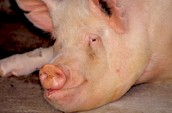This article offers a list of the most common parasites of swine, both external (ectoparasites) and internal (endoparasites) parasites.
common parasites of swine, both external (ectoparasites) and internal (endoparasites) parasites.
Detail information on their biology and control (life cycle, anatomy, prevention, chemical control, etc.) is available in specific articles in this site. To visit these specific articles click the corresponding link or use the site map.
- «$» to «$$$$$» indicates the magnitude of the economic damage for swine caused by a parasite on a worldwide basis. The more «$», the higher the damage.
- «R» to «RRRRR» indicates the magnitude of the resistance probems of these parasites to parasiticides on a worldwide basis. The more «R» the higher the risk of resistance.
External Parasites
Biting insects (hematophagous), i.e. they suck blood
- Black flies, gnats. $-R. Local problem in endemic regions, wordlwide, only on swine kept outdoors.
- Fleas. $-RR. Local problem in livestock kept indoors by warm and humid weather, worldwide.
- Midges. $. Local problem in endemic regions, worldwide.
- Mosquitoes. $. RRR. A worldwide problem in all kind of livestock, but usually not the major issue. No issue in swine kept indoors.
- Stable flies. $. Can be a significant problem in swine kept outdoors by warm and humid weather, worldwide. No issue in swine kept indoors.
- Tsetse flies. $$. A problem in Africa in all livestock kept outdoors.
- Horseflies. $. Usually a minor problem in all livestock kept outdoors by warm weather, worldwide. No issue in swine kept indoors.
Non-biting insects, do not suck blood
- Houseflies. $$$-RRRRR. Can be a serious problem in swine operations worldwide, both indoors and outdoors, mainly in the warm and humid season.
- Filth & nuisance flies. $-R. Usually a secondary issue in swine operations, mainly in the warm and humid season.
- Lice. $$. Very common problem worldwide, even in indoor operations, particularly during the cold season.
Myiasis: The insect larvae are parasitic, not the adults
- Human bot flies, Dermatobia. $. A problem in many regions of Central and South America, only on swine kept outdoors.
- Screwworm flies. $. Usually not a very serious problem for swine, unless outdoors in endemic regions in tropical and subtropical countries.
- Wohlfahrtia. $. Occasionally a problem in Mediterranean countries during summer on swine kept outdoors
Ticks (suck blood) & mites (don't suck blood)
- Amblyomma ticks. $. A problem only for grazing pigs in tropical and subtropical regions, mainly America and Africa. Not an issue for industrial pig production.
- Dermacentor ticks.$. A problem only for grazing pigs during the war season. Not an issue for industrial pig production.
- Haemaphysalis ticks. $. A problem only for grazing pigs in tropical and subtropical regions, mainly in parts of Asia Africa and Europe. Not an issue for industrial pig production.
- Hyalomma ticks. $$. A problem only for grazing pigs in tropical and subtropical regions, mainly in parts of Asia Africa and Europe. Not an issue for industrial pig production.
- Ixodes ticks. $. A problem only for grazing pigs in regions with moderate to cold climate, during spring and summer. tropical and subtropical regions, mainly America and Africa. Not an issue for industrial pig production.
- Rhipicephalus ticks. $. A problem only for grazing pigs in tropical and subtropical regions, mainly in Africa. Not an issue for industrial pig production.
- Mange mites. $$. A problem worldwide in all kind of pigs, also indoors. Ismfound worldwide but more frequent during the cold season in regions with temperate or cold climate.
Internal parasites (endoparasites, worms, helminths)
Predilection sites are indicated in brackets.
Gastrointestinal roundworms (nematodes)
- Ascaris suum. $$$. Pig roundworm. (Small intestine). Worldwide, more in tropical and subtropical regions.
- Globocephalus spp. $. Pig hookworm. (Small intestine). Worldwide, but regional incidence.
- Gnathostoma hispidum. $. (Stomach). Mainly Europe, Asia and Africa.
- Hyostrongylus rubidus. $$. Red stomach worm. (Stomach). Worldwide, mostly in mixed infections.
- Mecistocirrus digitatus. $. (Stomach). Worldwide, more in warm and humid regions. Mostly in mixed infections.
- Oesophagostomum spp. $$. Nodular worm. (Large intestine). Worldwide, mostly in mixed infections.
- Strongyloides spp. $$. Threadworms, pinworms. (Small intestine). Worldwide, more in warm and humid regions.
- Trichostrongylus axei. $$. (Stomach). Worldwide, mostly in mixed infections.
- Trichuris spp. $. Whipworms. (Large intestine). Worldwide.
Respiratory roundworms (nematodes)
- Metastrongylus spp. $$. Pig lungworm. (Trachea, bronchi, bronchioles). Worldwide.
Roundworms (nematodes) in the skin, heart and other organs
- Stephanurus dentatus. $. Kidney worm. (Kidneys). In tropical and subtropical regions.
- Suifilaria suis. (Skin). Southern Africa.
- Trichinella spp. $$. (Muscles, small intestine). Worldwide.
Flukes (trematodes, flatworms)
- Dicrocoelium spp. $. Lancet fluke. (Bile ducts and gall bladder). A problem only for grazing pigs worldwide. Not an issue for industrial pig production.
- Eurytrema pancreaticum. $. Pancreas fluke. (Pancreatic ducts). In South America, Asia and África, in swine kept outdoors. Not an issue for industrial pig production.
- Fasciola gigantica. $. Giant liver fluke. (Liver tissue, biliary ducts and gallbladder). A problem only for grazing pigs worldwide. Not an issue for industrial pig production.
- Fasciola hepatica. $. Common liver fluke. (Biliary ducts and gallbladder). A problem only for grazing pigs worldwide. Not an issue for industrial pig production.
Tapeworms (cestodes)
- Cysticercus cellulosae. $. Pork bladder worm. (Muscles). Worldwide in swine kept outdoors.
- Cysticercus tenuicollis. $. (Abdominal organs). Worldwide in swine kept outdoors.
- Echinococcus granulosus. $$. Hydatid worm. (Various organs). Worldwide in swine kept outdoors.